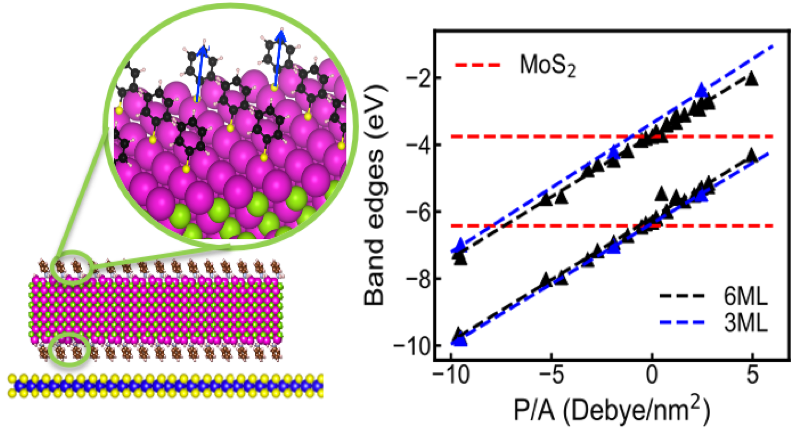 Most inorganic quantum dots (QD) are obtained through organic synthesis using surface ligands. When deposited on two-dimensional (2D) materials such as MoS2, such ligands form an “interlayer” between the components of the resulting mixed-dimensional heterojunction. To understand the effects of this interlayer, a collaborative theory and experimental effort in NU-MRSEC IRG-1 effort has modeled and characterized the electronic structure of CdSe nanoplatelets (NPLs) with well-controlled ligand-dipole terminations. The electronic band-offsets of these NPL/MoS2 heterojunctions are found to be strongly impacted by the ligand areal dipole, with continuous tunability for commonly used ligands. This scheme can be used to design optical excitations over a broad energy range in mixed-dimensional heterojunctions.
Most inorganic quantum dots (QD) are obtained through organic synthesis using surface ligands. When deposited on two-dimensional (2D) materials such as MoS2, such ligands form an “interlayer” between the components of the resulting mixed-dimensional heterojunction. To understand the effects of this interlayer, a collaborative theory and experimental effort in NU-MRSEC IRG-1 effort has modeled and characterized the electronic structure of CdSe nanoplatelets (NPLs) with well-controlled ligand-dipole terminations. The electronic band-offsets of these NPL/MoS2 heterojunctions are found to be strongly impacted by the ligand areal dipole, with continuous tunability for commonly used ligands. This scheme can be used to design optical excitations over a broad energy range in mixed-dimensional heterojunctions.